The Real World Dangers of Diving and How To Prevent Them
The Real World Dangers of Diving and How To Prevent Them
It’s no secret that our community boasts the highest rate of concealed carry permit holders. In fact, you could likely ask any of the members at ITS to recommend a pistol for a beginner and you’d be met with a barrage of opinions. Some prefer Smith & Wesson, others Glock and some Sig Sauer. While we’ll never agree on which firearm is the best, we will agree on one key piece of kit; training.
I don’t know anyone that truly believes their concealed carry course was sufficient enough to be the only training needed to carry a firearm. This isn’t because the training could have been better, it’s that we’re all looking to be as proficient as we possibly can be. This intense desire to become better in every facet of our lives, drives us and those around us to be the very best versions of ourselves.
Our hobbies are no different and diving is one of mine. In this article, we’ll be touching on some of the less-frequently discussed dangers in SCUBA diving and how you can mitigate these pitfalls with awareness and training.
DCS Type I and II
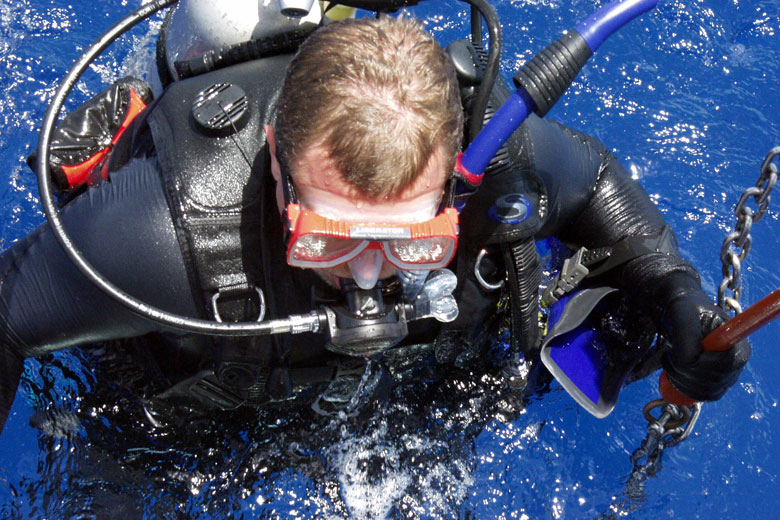
Decompression Sickness (DCS), Cassion’s Disease, the bends. While these are all terms for the same thing, what exactly is it? This is one of the more common topics in any diving coursework, but in my opinion, there’s insufficient information afforded to those learning to dive. With diving, there are understandably a lot of tasks that need to be completed safely and in a timely manner. This is just one more thing to be aware of in our mission to continuously gain information in order to be our best selves.
When you strap your dive computer onto your wrist, you’re not just getting a fancy watch with some depth algorithms thrown in there. In fact, these computers represent years of research in diving coupled with our best guesses at what those predicted outcomes will be. These diving algorithms utilize doppler information of over 16 different tissues in the body. Some tissues will “on-gas” (absorb) faster than others and are referred to as “fast tissues.”
At the other end of this spectrum are the “slow tissues.” These tissues will on-gas and off-gas much more slowly than the fast tissues. This difference in gas molecule absorption rates can present interesting challenges in decompression of nitrogen or other mixed gases in the tissues of the body. This can be a contributor in “undeserved hits,” where a diver is bent even after following their conservative profile and computer.
There will be no debate here about the Buhlmann vs. Bubble models or gradient factors, as they relate to technical diving and are beyond the scope of this article. Future articles may cover decompression algorithms in greater detail, but it’s essential to gain a solid understanding of the information we hope to convey here. Now, let’s talk about what happens to your body and where these gases come from as you move through your dive.
Your dive computer monitors your depth and time as you progress through the dive in an attempt to deliver its best guess at your level of dissolved gases in each layer of tissue. Let’s say you descend to a depth of 33 ft (10M) and stay there for one hour. Likely, nothing noteworthy has happened. Now let’s say you cruise down to 150 ft (45M). According to IANTD Air Decompression Table C-3800B, you can stay there for 10 minutes and you’ve earned yourself a four minute Decompression/Safety Stop at 15 ft (4.5M).
Where does the 10-minute window come from, though? This is that DCS thing your instructor was talking about. Nothing magical is happening to your body at these depths; on-gassing is a simple by-product of physics. As the ambient pressure around the body increases, the pressure within your cells becomes negative. As a result, gas molecules begin to pass through cell membranes and equalize the pressure differential between the tissues and the surrounding environment.
As mentioned, some tissues do this more quickly, others more slowly. Once the maximum bottom time is expired, the diver must begin the slow process of ascending to the surface. In our IANTD table, a four minute stop is required to safely off-gas. I’ve explained how gases work their way into the tissues, so it should be apparent that, according to Boyle’s Law, the gases will expand upon ascent. This increases the pressure within the tissues and the gases begin to move back into the environment with the negative pressure differential.
When the pressures have equalized, or at least reached something very close to the ambient pressure on the surface, the diver may exit the water and head immediately to the bar (don’t head immediately to the bar). These times do not reflect full saturation of gases, but rather represent a safe point at which recreational diving may be performed based on present technology.
You may be thinking, “well if the pressure will equalize anyway, what’s the point in decompression stops at all?” You would be theoretically correct, as the body will eventually return to its normal state. The problem is not, will the body return to a normal state, but rather, how much of a pressure differential can the body’s tissues handle? It turns out that the answer is “not very much.”
When the pressure isn’t released slowly through decompression, the gases will expand and gas bubbles will form. These bubbles move through the bloodstream and collect in the joints, causing intense pain or immobility. The gases can rupture tissues within the cardiovascular or nervous systems, resulting in symptoms similar to a stroke, heart attack or can even cause death.
Type I vs Type II
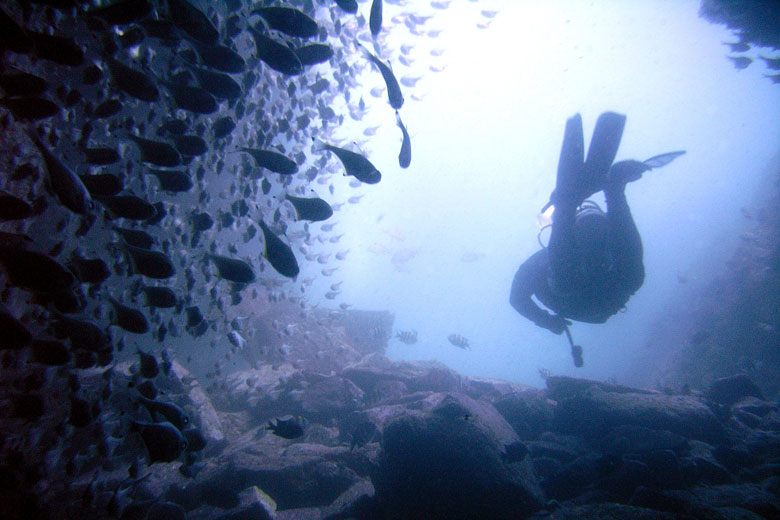
When dealing with Type I DCS vs. Type II, each type deals with the severity. Type I being first, is less severe. Typically, a diver with Type I DCS experiences mild pain in some joints. The joints affected seem to be random, but may be influenced by gaps in exposure protection, previous injuries or a slew of other factors. The diver may also display a marble-like rash in random places as well.
These symptoms typically resolve with inhaled oxygen, however the signs of DCS represent the early stages of the progressive disorder and should be treated by a physician as soon as possible.
Type II is more severe and presents a massive list of ailments from severe headache and confusion, to loss of bowel control. DCS Type II can be difficult to notice because the onset varies so wildly from person to person. Some people may have their first symptoms within moments of surfacing and others may not notice a problem until they’re driving home from the dive.
Some rare cases have seen DSC symptoms manifest as far out as 18 hours. Generally, if the diver isn’t in a panic or shock from an accident, the signs and symptoms progress through Type I with mild pain. The difference here is that the diver may begin to lose coordination, balance or consciousness. Look for signs of confusion, extreme fatigue, or a choking cough. These are some early warning signs that may save the diver’s life.
Remember that it’s better to be safe than sorry when concerning ourselves with Decompression Illness. Many healthcare and diving organizations insist that the divers not allow denial to exist when faced with the slow onset of these symptoms. It may be harder to recognize. Below is a list of symptoms available from the Divers Alert Network. This list of symptoms is widely available across the Internet and textbooks as well.
- Pain, particularly near the joints
- Numbness or paresthesia
- Constitutional concerns — such as headache, lightheadedness, unexplained fatigue, malaise, nausea and/or vomiting, or anorexia
- Dizziness or vertigo
- Motor weakness
- Cutaneous, or skin problems — such as an itching, rash or mottling “cutis marmorata”
- Muscle discomfort
- Impaired mental status
- Pulmonary problems — such as breathing difficulties “the chokes”
- Impaired coordination
- Reduced level of consciousness
- Auditory symptoms — such as hearing sounds that aren’t there or having a hard time hearing
- Lymphatic concerns — such as regional swelling
- Bladder or bowel dysfunction — such as retention of urine
- Compromised cardiovascular function
Explaining DCS to a Healthcare Provider
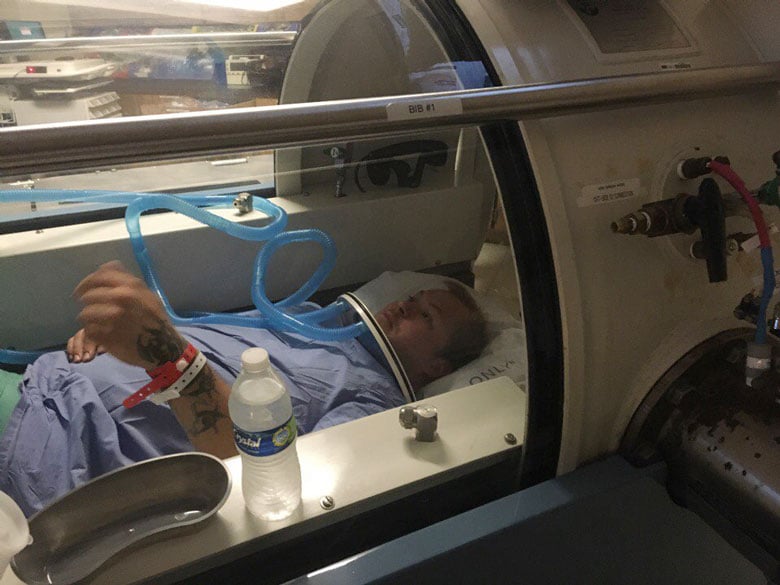
Yes, you read that correctly. I’ve seen many cases where individuals were cleared for diving by their Primary Care Physicians without a clear understanding of diving physiology. I’m not a doctor, but I’ve been in healthcare and diving long enough to have a firm grasp of the physical requirements this sport entails.
The scariest moment of my diving career was laying in a hospital bed on O2, while they prepared the recompression chamber. During this time, I was tasked with explaining the principles of CCR and variable FO2 to a (very attractive) surgeon while in agonizing pain; distraught by the fact that I had no idea if anyone else made it out of the water at all. The hospital was very knowledgeable and very attentive, but Closed-Circuit Rebreathers present a unique set of challenges for medical personnel.
In the event you’re diving with stage gases or any system that changes the fraction of Oxygen in your breathing gas, write it down. Think of something simple to explain this procedure, because these people are doctors, not technical divers. I’ve heard stories about physicians that knew exactly what to do with the technical diver, but there are also cases like mine, where a group of providers had to take notes on my explanation of Partial Pressures to ensure I was treated properly.
O2 Toxicity- Making sense of the numbers
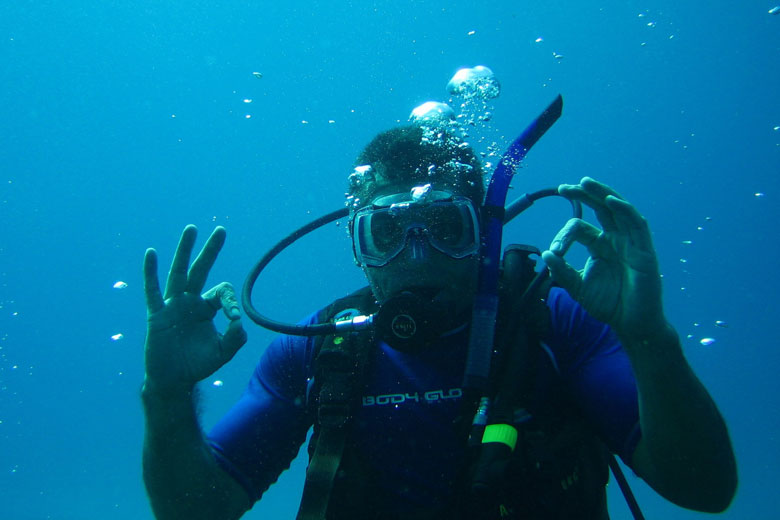
It’s understandable that our eyes glaze over when we talk about theoretical oxygen content and how different decimal points are derived. In many articles, both here and in the wild, you’ve likely seen that the 1.6 ATA limit is the end of the line. The instructors drill it into our heads during the NITROX courses and they paint a picture that says, “you hit 1.6ATA at depth and then you die.” That’s not true. In fact, the US Navy uses a standard that loosely sets this range at 2.0.
So what’s going on in your body during these dives and where do these numbers come from? The down and dirty numbers on how Oxygen mixtures correlate to how atmospheres are obtained, has been discussed in a previous article, so we won’t go into that here. We want to talk about what these numbers mean for the recreational diver and how you can enjoy your dives more with a clearer understanding of what you’re doing to your body.
PPO2 (Partial Pressure Oxygen) and its affect on the body, is actually quite predictable through many years of research by many government agencies. It’s important to remember that every single body is different on every single day.
You could dive the same exact profile 10,000 times, but one day your body may do something a little differently and winds up getting you bent. It’s not inherently good or bad, it is what it is.
To keep it simple, the Navy Experimental Dive Unit has settled on a set of numbers that work for the Military, while private companies and researchers have agreed on more conservative numbers. Typically, a recreational diver won’t have to worry about these numbers in any great detail.
This is simply because these divers won’t have to capability to stay long enough at any meaningful depth with enriched air. Though that doesn’t mean we shouldn’t talk about it.
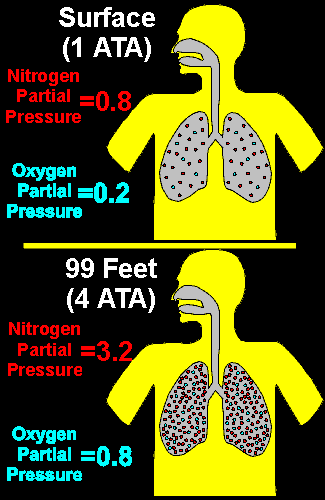
Research shows that humans can withstand increased partial pressures of Oxygen up to .45 ATA without any problem. Within these safe zones, the body is able to repair damage caused to the cells by Oxygen Radicals at a rate sufficient to sustain life indefinitely. As we increase the content of our O2, however, the damage begins to exceed the body’s ability to heal itself.
Thinking about this proportionally, we can understand how the higher contents and longer duration impacts our health. More O2 ultimately means more damage at a faster rate. “The time to onset of symptoms is highly variable, but most individuals can tolerate 12-16 hours of oxygen at 1.0 ATA, 8-14 hours at 1.5 ATA and 3-6 hours at 2.0 ATA before developing mild symptoms.” (David Sawatzky, M.D., Exploration and Mixed Gas Diving Encyclopedia, Pages 41-49, IANTD 2008)
Now that I’ve put this information out there for the rest of the free world, let’s talk about why you’re diving a 1.4 on your profile.
There are two limits to consider with O2 Toxicity; the pulmonary limit (1.6) and the CNS (Central Nervous System) limit (2.0). This means effects on the pulmonary system are observed after several hours of breathing at a PPO2 of 1.6 ATA.
Symptoms in the Central Nervous System are observed at pressures greater than 2.0 ATA. According to the US Navy Dive Manual (3-9.2.2), “CNS Oxygen Toxicity can occur whenever the oxygen partial pressure exceeds 1.3 ATA in a wet diver or 2.4 ATA in a dry diver. The reason for the marked increase in susceptibility in a wet diver is not completely understood.”
Oxygen Toxicity and Its Effect on the Pulmonary System
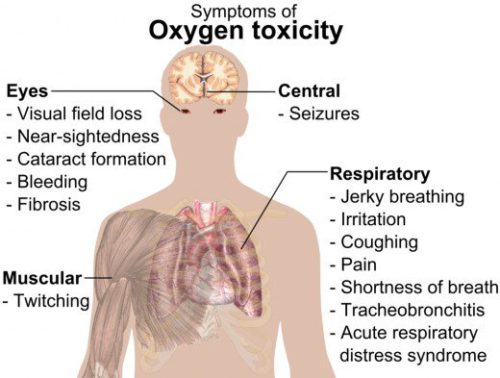
To make sense of the two stages, let’s discuss the effects that Oxygen Radicals have on the pulmonary system now and follow up with CNS. Usually, pulmonary signs and symptoms manifest with enough time for the diver to react. The diver should notice a marked progression in signs from a mild burning in the chest and throat, to a consistent and deep cough.
The cough progresses as you would expect it to while breathing in, say, too much smoke from a campfire. The lungs and throat will burn upon inhalation. This pain will gradually increase until a mild cough forms. The mild coughing progresses to a deep, uncontrollable cough. Finally, the diver will lose consciousness as the lungs become so damaged that they can no longer metabolize oxygen.
So to clarify, too much oxygen leads to burning and coughing, which leads to unconsciousness from lack of oxygen. I’m sure that makes sense.
Central Nervous System Oxygen Toxicity
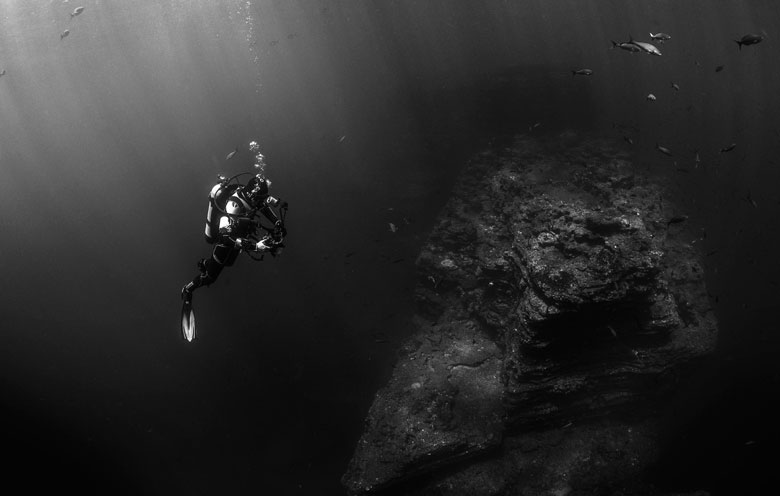
CNS Oxygen Toxicity is the level at which your body can no longer recover from the damage caused to your Central Nervous System by Oxygen Radicals. These radicals are a byproduct of your body’s metabolism of oxygen and are simply unavoidable unless you can find a way to survive without O2.
To reiterate, we avoid this problem by decreasing the Partial Pressure of Oxygen in our breathing gas. If the Partial Pressure of Oxygen is exceeded by a volume high enough and for a duration long enough, the diver will begin to experience auditory hallucinations, such as a whooshing sound or barking dogs. Shortly thereafter, the diver will experience an “oxygen seizure.”
The seizures can actually be survived and in fact, are survived quite frequently in the recompression chambers. To paint a more grim picture, the diver is typically incapable of retaining the regulator, or may even bite through the mouthpiece. This leads to the more obvious scenario; drowning.
The signs and symptoms are not a progression from Pulmonary to CNS. The consequences of Pulmonary Oxygen Toxicity are well underway at this point. The marked difference is simply that CNS signs and symptoms don’t normally manifest until about 2.0 ATA.
Every human being is different and the research reflects dramatically different results based on the method in which you’re diving. To be certain that you’re not putting yourself in danger, follow the conservative NITROX/ TRIMIX tables you’ve received from your certification agency. No table or mathematical formula can guarantee your safety underwater, but it can dramatically decrease the risks associated with mixed-gas diving.
If that’s not enough, run through the scenario in your head where you’re explaining to the EMT that your dive buddy is dead because he/she tox’d out so you could gain two extra minutes at the bottom. Those are the real gains you earn yourself when you play with the numbers. Many have gone before us to ensure we can be as safe as possible, so if you want more bottom time, then I implore you to seek additional training.
Hypercapnia
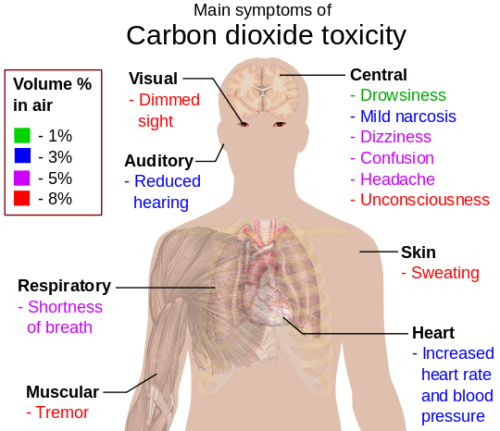
When it comes to Hypercapnia, I’ll start by saying that it’s extremely unlikely that the average recreational diver will experience this problem while using standard diving equipment. Hypercapnia is, very simply, when too much carbon dioxide exists and persists in the bloodstream. On Open-Circuit, this can happen to you at extreme depths or depths when the gas mixture is inappropriate.
As you descend, the gas becomes thicker as it pours from your regulator into the ambient pressure in your lungs. Air can be like breathing a milkshake at 200 ft. (61M). Some people have experienced this, but the narcosis on air at 200 ft. is nothing short of fierce.
When the air thickens, less gas is exchanged through the tissues in the lungs, resulting in below average expiration of CO2. This can be exacerbated by heavy exertion underwater or by “skip-breathing.”
Yes, we’re going to talk about skip-breathing because it can cause you some serious problems underwater. For the unfamiliar, “skip-breathing” is where divers will hold their breath for a short time between most or all inhalations in an attempt to conserve breathing gas. As the diver swims through the water, the exertion produces more CO2 and the CO2 level isn’t expired as quickly as necessary to ensure adequate ventilation. So, stop skip-breathing.
Once the CO2 saturation becomes high enough, no volume of oxygen is going to keep you awake. The worst part about this whole thing is that the diver is typically unaware there’s a problem while the CO2 is loading. Excess carbon dioxide inhibits the mental processes to such an extreme degree that the diver may fall into a state of denial and accept catastrophic problems as not that serious, or even continue to dive in a dangerous situation.
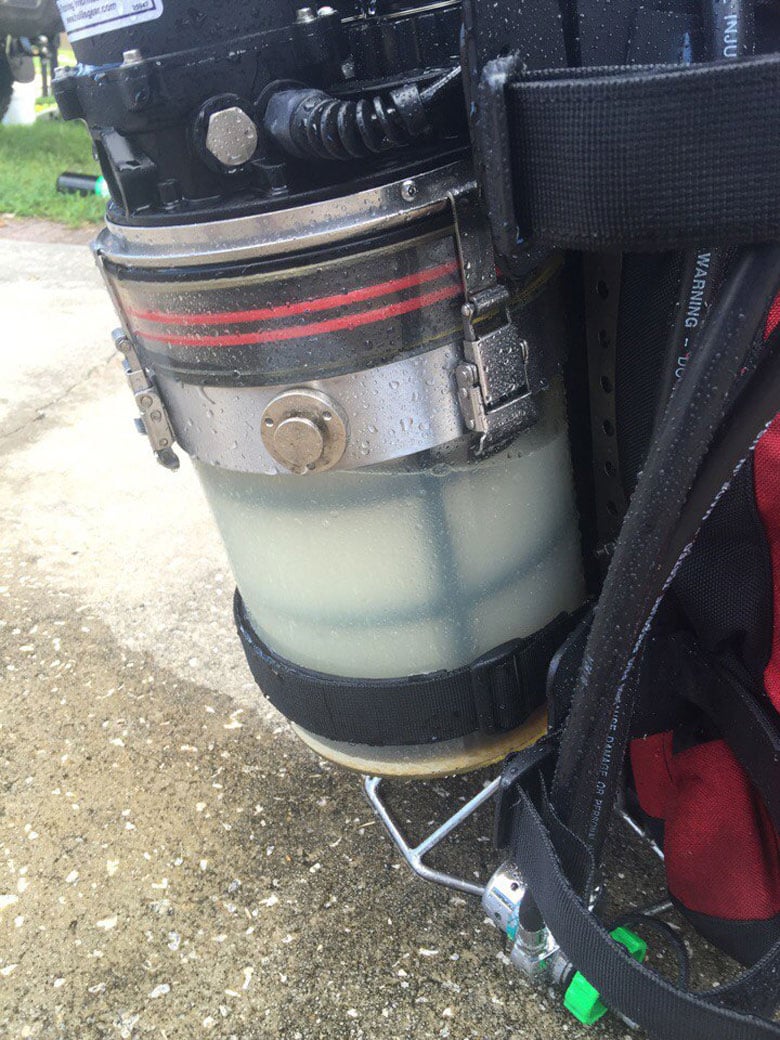
Bad gas can also cause Hypercapnia. No, I don’t mean that sketchy TexMex place down the road, I mean the gas in your tanks. Most diving outfits are required to maintain strict standards for how they draw the air through their compressors, but history tells us this isn’t always the case.
Instead of quoting several examples, you can jump on a Google search and find numerous accounts of diving facilities offering up bad gas-mixtures. These problems range from trucks idling in the alley behind the shop where the compressor draws air to poorly maintained/unsuitable compressors being used to fill tanks.
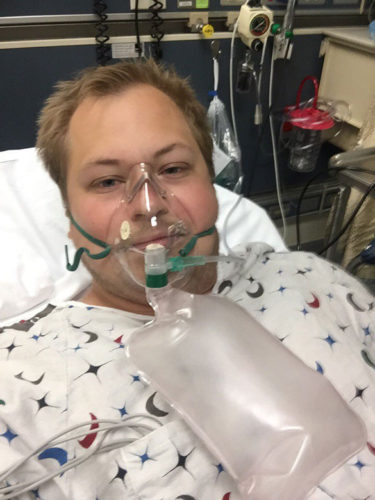
CO2 poisoning, in my case, (yes I earned a CO2 hit on my second dive after being bent) manifested in a headache, rapid pulse, tingling in the lips and fingers and heavy breathing. This occurs because the mechanism that monitors CO2 in your body reads the increased level of CO2 as a demand for more O2, due to higher exertion.
I knew there was a problem because I was taught to stay alert to changing conditions during my dive. You can detect these changes as well with a simple battery of questions for yourself. I regularly consider my breathing as I’m walking around. During a dive, the level of exertion is similar and should be very similar to breathing on the surface and this becomes my bench mark for CO2 retention.
I draw the line before each dive. If my breathing exceeds my normal breathing rate for more than five-six breaths and does not show signs of improvement, then I have a problem and it’s time to leave. Lips tingling and numbness in the fingers is also not normal. Develop some questions and draw very clear answers. CO2 will take any leeway you give it during an emergency.
TL;DR: Some Guidelines to Keep Everyone Safe
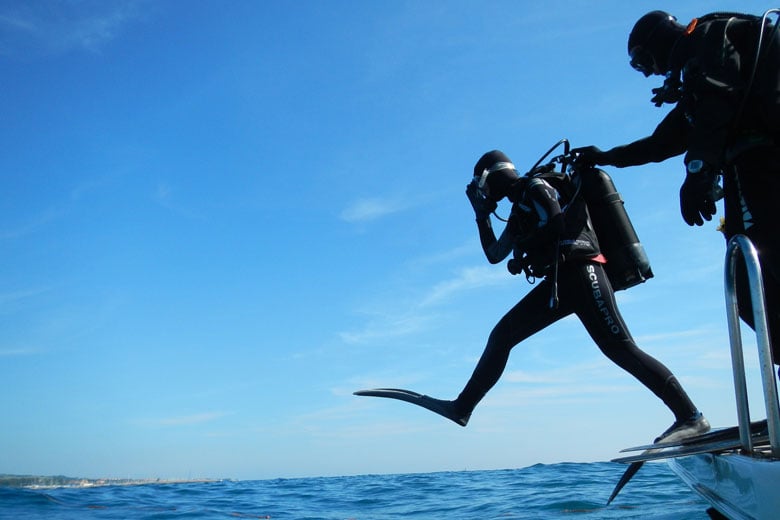
First and foremost, listen to the silly acronyms and mnemonics that persist in the diving industry. The army uses “Stay Alert, Stay Alive” as a constant reminder to soldiers that danger is lurking everywhere. This is true in diving as well. Danger is constantly waiting to reach out and grab you.
Constantly evaluate your mental status. If something feels wrong, it is. Don’t panic, but remember that there’s no shame in aborting a dive. All technical diving agencies I’m familiar with insist that “Any diver may call the dive at any time and for any reason.” I assure you, losing the $85 because you didn’t get in the water is completely acceptable to avoid the $14,000 in medical bills the insurance doesn’t cover because you went on a dive you weren’t prepared or experienced for.
Dive within your limits. If you’re unsure of something, err on the side of caution and get the proper training to complete more intense dives. We don’t place warning signs in caves and scream about penetrating a shipwreck because we stand to gain something, we want everyone to enjoy the sport. If someone has an ego in this game, that’s fine, but it may get them killed because they have something to prove. Don’t be that guy. Pay attention and stay alert, but also remember to enjoy your dives. That’s what this is all about in the first place.
Editor-in-Chief’s Note: Derek Gill has been a Plank Owner here at ITS from the beginning and has an extensive background in healthcare, pharmaceutical research and technical diving. He’s been certified in SCUBA since 2000 and diving technical/CCR since 2010. He speaks several languages including Russian and Spanish as well as several computer languages. These combined skills have opened the door to more creative ventures in Network Security and Physical Security consulting. Derek is a veteran of the US Navy and a former Navy Corpsman who worked alongside the US Marine Corps. His military nickname, “Witch Doctor,” has stuck with him ever since and it can now be found across many internet forums where he takes pride in trolling sensational zealots from multiple industries.






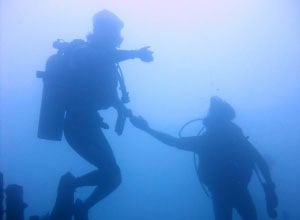
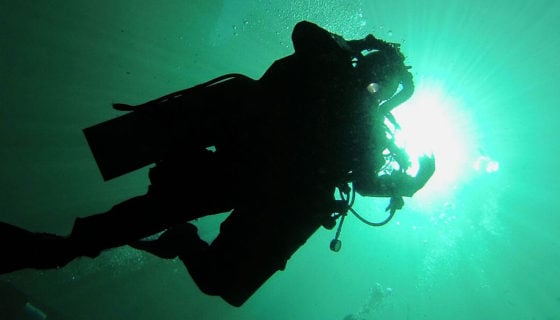
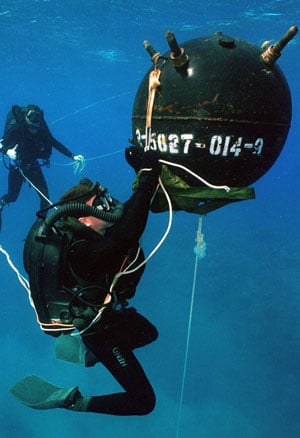


Discussion